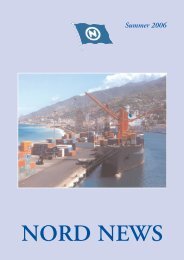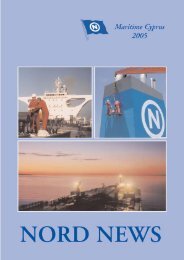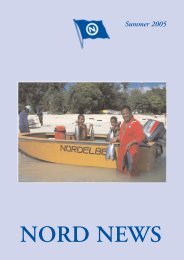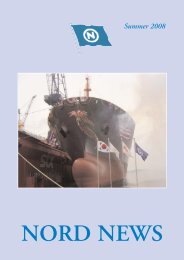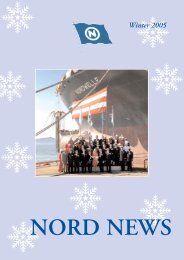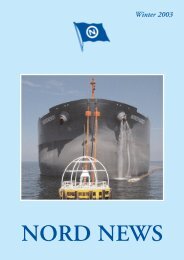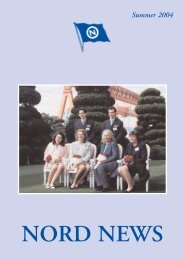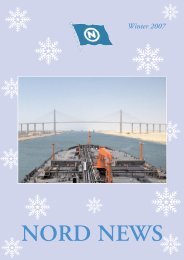Nord news
Nord news
Nord news
You also want an ePaper? Increase the reach of your titles
YUMPU automatically turns print PDFs into web optimized ePapers that Google loves.
How it all started<br />
company and bought a coastal tank ship operation<br />
the "Pan Atlantic Steamship" company. He then<br />
set out to make his vision a reality. The small fleet<br />
of the "Pan Atlantic Steamship" consisted of World<br />
War II built T-2 Tankers. The ships were already<br />
fitted with a wooden spar deck to carry fighter<br />
aircrafts. With minimum modifications the<br />
container age began on April 26, 1956, at New<br />
Jersey when the first T-2 tanker was loaded with<br />
58 trailers for transportation to Texas.<br />
Realising that the use of Tankers was not very<br />
convenient and that a ship that could carry boxes<br />
below decks would be more efficient, more<br />
vessels were converted and in 1957 the first of<br />
these vessels "Gateway City" entered service.<br />
Their decks were cleared, their width was<br />
increased by sponsons and they were fitted with<br />
two rail mounted gantry cranes giving them self<br />
sufficiency. They were able to lift 35 ft vans<br />
from the quayside and stow 226 of them on deck<br />
and in the holds. In 1959 the Pan Atlantic<br />
became the "Sea-Land Service" serving a growing<br />
number of ports, buying tankers, cargo ships and<br />
military surplus vessels and converting them to<br />
container ships. Containers were also developing<br />
fast and soon the basic dry box was developed<br />
which evolved into refrigerated and ventilated<br />
containers, side loading units and “open tops”,<br />
inside stout frames of appropriate dimensions<br />
and a whole range of other specialist units.<br />
By the end of the 1960's the 42 ships of the US "Sea<br />
Land" were covering both the Atlantic and the<br />
Pacific ports and the Japanese and Europeans were<br />
developing and building their own containerships.<br />
Mr. McLean sold his interest in the flourishing “Sea-<br />
Land” Company in the late 1960's and turned his<br />
attention to other interests like real estate and life<br />
insurance. He returned to marine transport in the<br />
late 1970's with the purchase of the United States<br />
Lines and introduced a round the world service with<br />
a dozen 4,456 teu ships. These Jumbo-Econoships<br />
were launched in 1984 and they successfully<br />
transited the Panama Canal. But the quadrupling of<br />
fuel prices and the economic circumstances rendered<br />
them uneconomical and they had to be scrapped.<br />
With the introduction of containerisation, ports<br />
that were dependent on manual labour and<br />
stevedoring went into sharp decline and became<br />
largely obsolete. However, its benefits are vast<br />
and undisputable. Briefly, they relate to greater<br />
efficiency and reduced costs, faster and larger<br />
vessels, reduced delays in port, and greater cargo<br />
security.<br />
Nowadays, goods are transported in standard<br />
sized containers from trains to ships and can be<br />
transported worldwide in a “Door to Door”<br />
service. Almost every manufactured product we<br />
consume spends some time in a container.<br />
Approximately 90% of non-bulk cargo<br />
worldwide moves by containers stacked on ships<br />
and 26% of all containers originate from China.<br />
As of 2005, some 18 million total containers<br />
make over 200 million trips per year. There are<br />
ships trading that can carry over 9,000 TEU.<br />
Maersk, the biggest container company in the<br />
world that bought over “Sea Land” have now<br />
launched the “Emma Maersk”, a 11,000 TEU<br />
nominal capacity vessel and designers are<br />
working on ships capable of carrying 14,000<br />
TEU. Predictions have also been made that at<br />
some point the size of container ships will only<br />
be constrained by the Straits of Malacca (one of<br />
the world's busiest shipping lanes), with ships as<br />
long as one quarter of a mile and 190 feet wide.<br />
Mr. McLean died in 2001, at the age of 88.<br />
He was the "father of containerization" and also<br />
one of the principal architects of a technology<br />
that has facilitated the world trade and<br />
globalization. He revolutionized and sped up<br />
cargo shipping and the entire transportation<br />
chain and reduced its costs, so that people<br />
throughout the entire world are now able to<br />
bring their products to the global marketplace.<br />
In memory and recognition of Malcom McLean's<br />
achievement, the US Merchant Marine Academy<br />
at Kings Point is to become the home for a<br />
collection of records, photographs and artifacts<br />
relating to the history of containerization and it<br />
will be called the "McLean's Container Centre".<br />
NORD NEWS Autumn 2006 5



